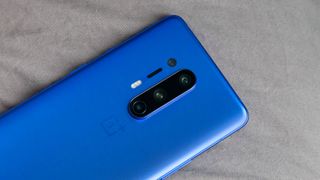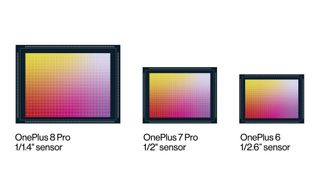OnePlus 8 Pro camera: Here's why Sony IMX689 sensor matters
Joining the big boys

OnePlus just took the wraps off its new phones for the season with the OnePlus 8 and 8 Pro. As always, the focus was on speed — powerful internals, high refresh rate displays, and fast charging. As exciting as those may be, OnePlus has never really struggled in those aspects.
Ever since the first OnePlus phones, the company has tried to provide a smooth user experience along with the latest specifications. But as it matured into the premium flagship segment, weakness such as incompetent cameras stuck out like a sore thumb in an otherwise amicable package. With the manufacturer inching towards higher price points, the cameras could no longer be just “above average”.
The OnePlus 8 Pro camera takes the biggest generational leap when it comes to the camera hardware. Multiple factors are involved in creating an image when the shutter is clicked, which determines what sort of image will be generated. Let’s understand how smartphone cameras work to get a better idea.
How cameras work
As mentioned earlier, photography on phones is a complex combination of hardware and software efforts. On the surface, all cameras are basically just a function of light hitting a sensor, which then gets converted information, which can be interpreted by the processor, which then processes the image and spews out the final image.
At first, the sensor produces an unprocessed image, which the phone then decides how to improve. It includes adjusting the highlights and shadows, fixing the white balance, tuning contrast and saturation, and making small fixes if needed. Without this processing, images out of a camera will appear rather unpleasing. The process of capturing a “RAW” image is somewhat similar, where the phone does not do the editing, giving the photographer more room to play with the image in post-processing.
While the software processing differs for each phone, functions on the hardware front are a little more straightforward and unform, but involves many elements. For example, the photos first pass through the lens and then hit the image sensor. The aperture determines how much light will be allowed through, while the shutter speed will regulate how long the sensor will be exposed.

The physics is the same across all smartphones, but the lens composition, type of glass, aperture size, sensor size, and sensor composition vary between all phones. Understanding these parameters will also explain why results from a phone are so different from that of an actual camera, with the sensor size being the key differentiator. All of these parts play a role in how the final image is created, with a variation on either side giving a different “look” to your image.
Get daily insight, inspiration and deals in your inbox
Sign up for breaking news, reviews, opinion, top tech deals, and more.
For example, the aperture, which is a ratio of the camera’s focal length to the diameter of the diaphragm (the opening), primarily affects how much light will be let in. It is expressed in f-stops. For instance, primary cameras on smartphones typically have a focal length (field of view) of around 25mm and an aperture of f/1.8. Unlike shutter speed, the aperture is a relative unit, and comparing the f-stops between a phone and a DSLR would be incorrect, as the sensor size is massively different.
All you need to know as a photographer is two things: A wider aperture will provide for a brighter image and a shallower depth of field (generally referred to as bokeh). A smaller aperture will bring more of the subject in focus but make for a darker image (provided other factors are constant). Unlike dedicated cameras, the aperture on smartphones can not be changed. Till a few years ago, smartphone manufacturers were racing towards achieving bigger apertures on the camera but eventually reverted to the sweet spot of around f/2.0. A significantly wider aperture comes with its own cons, such as difficulty in focusing, unmanageably shallow plane of focus, chromatic aberration, and even a lack of contrast.
So, the aperture can be said to be a double-edged sword. The sensor size, on the other hand, is simpler — a bigger sensor will give a cleaner look to image with better details, more depth of field, and improved low light performance and dynamic range. Sadly, this is also the most challenging element to improve as space is very limited inside a phone and increasing the sensor. Corresponding optics mean other components get lesser space.

Most smartphones sport a sensor that is just about 1/2-inch across, with the flagships being just a little bigger. A bigger sensor also allows for individual pixels to be bigger, for better colors and low light capabilities. This is why many manufacturers offer pixel binning on their smartphones. Pixel binning is the process of combing adjacent sub-pixels to create a “superpixel” which is manifold bigger.
It is technically difficult to just make sensors with bigger pixels, which is why manufacturers resort to higher resolution sensors and then combine the additional pixels to replicate the effect. Most cameras can combine four adjacent pixels, but some flagships take it further to even 9 and 16 to 1 binning.
OnePlus 8 Pro camera
| Header Cell - Column 0 | OnePlus 8 Pro | Huawei P40 Pro | Samsung Galaxy S20 Ultra | iPhone 11 Pro |
|---|---|---|---|---|
| Image sensor | Sony IMX689 | Sony IMX700 | Samsung ISOCELL Bright HM1 | Sony (custom) |
| Sensor size (in inches) | 1/1.43 | 1/1.28 | 1/1.33 | 1/2.55 |
| Native resolution and pixel size | 48MP, 1.12μm | 50MP, 1.22μm | 108MP, 0.80μm | 12MP, 1.4μm |
| Pixel binning level | 4 in 1 | 4 in 1 | 9 in 1 | none |
| Binned resolution and pixel size | 12MP, 2.24μm | 12.5MP, 2.44μm | 12MP, 2.40μm | - |
It brings us to the OnePlus 8 Pro, which sports a new Sony IMX689 image sensor. This sensor was exclusively developed for Oppo, but the close association between the two companies has let OnePlus to equip it on its latest flagship.
It is one of the biggest image sensors available for smartphones currently, spanning 1/1.43-inches diagonally. Only the Huawei P40 Pro and the Samsung Galaxy S20 Ultra have bigger image sensors and are also significantly more expensive. They also have a higher resolution than the OnePlus 8 Pro.
OnePlus’ implementation of the Sony IMX689 image sensor involves spreading the 48MP resolution for a respectable resultant pixel size of 1.12µm. By default, it employs pixel binning to create images at 12MP with a pixel size of 2.24µm, which is one of the highest on any current smartphone. That is paired with an f/1.78 lens for ample light to be let in.
The OnePlus 8 Pro has a quad-camera array on the back, which also consists of a 48MP ultra-wide shooter, an 8MP telephoto shooter with 3x effective magnification, and a new colour filter sensor which allows for dynamic lighting and colour effects. On the software side, we get features such as a new “Single frame 3-HDR” shooting mode, all-pixel AF, UltraShot, Nightscape, etc.
Combining the capable hardware with a new image processing algorithm, we see the OnePlus 8 Pro provide the best images ever seen on a OnePlus. We will be pitting it against the competition to see how the “flagship killer” fares. To get a detailed report of what the OnePlus 8 Pro’s cameras can do, you can check out our extensive review.
Aakash is the engine that keeps TechRadar India running, using his experience and ideas to help consumers get to the right products via reviews, buying guides and explainers. Apart from phones, computers and cameras, he is obsessed with electric vehicles.
Most Popular


